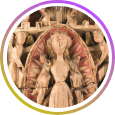Master''s Triptych of the Crucifixion, transitional style, and blessing cross. Amhara culture, Ethiopia, S. XVI. Pieces with base.
Triptych measures: 17 x 26 cm (open, without base); Cross measures: 34 cm high (without base).
Ethiopia became part of the Christian community in the same century as the Roman Empire, between 325 and 350 AD. C.
Before the arrival of Islam, Ethiopia was a rich empire that minted its own currency and controlled trade in the Red Sea. The Ethiopian merchants and monks who made a pilgrimage to Jerusalem were the first to bring illuminated manuscripts with Christian images to these lands. However, it was not until the fifteenth century for the panel painting technique to make its appearance by an artist from Venice, the monk Nicolò Brancaleon. Its rapid spread was due to the fact that the icon provided the believer with a more intimate means of communication with the divinity.
This icon dates from the second half of the 16th century, when the style called "parallel lines" appeared due to the way in which the clothing is painted, very typical of this period.
The construction of this icon follows the pattern of Nicolò Brancaleon''s triptychs: the scenes narrated on the side sheets develop the devotional theme painted on the central panel. Thus, the redemptive sacrifice of Christ is contemplated with anguish by Mary and Saint John, located on both sides of the Cross, to which the twelve apostles also direct their gaze from the side panels. Three angels collect the sacred blood of Christ in chalices, a gesture that demonstrates the Eucharistic significance of the Crucifixion. The left panel shows the theme of the Resurrection symbolized by Christ descending into hell to redeem Adam and Eve.
Another essential liturgical object of the time was the cross. The importance of this symbol is evident when it is represented in the hands of the apostles. Very few iron crosses made between 1530 and 1650 have survived due to their limited production. Its design bears witness to the influence of the arrival of the Portuguese in Ethiopia, without abandoning the secular tradition.
These crosses accompanied the priests in their daily lives. Always tied to their cloak, they took them on their constant trips on horseback and blessed the believer with them.
This lot requires export license
 DECORATIVE ARTS
DECORATIVE ARTS
Starting price
5.500 €
HAMMER PRICE
5.500 €
duran-app.lot.title_phone_bid
Phone 1:
Phone 2:
Comments:Confirm your maximum bid
At the time of auction we will contact you by phone:
Confirm your maximum bid
Loading…
Conecting with the server
Are you sure you want to buy the lot?
Durán Sala de Arte 2024
Confirm your maximum bid